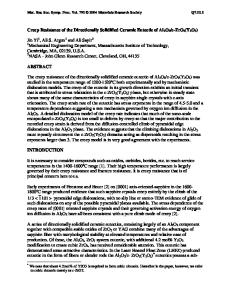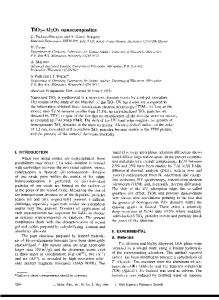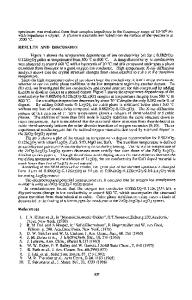Liquid and Glassy State Polyamorphism in the System Y 2 O 3 -Al 2 O 3
- PDF / 1,081,570 Bytes
- 3 Pages / 414.72 x 648 pts Page_size
- 0 Downloads / 554 Views
A very weak endotherm could just be distinguished in our data at 888 0 C, which could correspond to a glass transition. The density of the bulk glassy material was measured by pycnometry to be 3.7 g/cm 3 , and the longitudinal and transverse sound wave velocities were 6.826 and 3.740 km/s. The samples at the AY-24 composition prepared by roller quenching showed several interesting features. One glass was essentially "single phase", but all the others synthesized in this way contained a large fraction of the second (low temperature, lower density) glassy material, as beads dispersed within a glassy matrix of the matrix corresponding to the high temperature liquid (Fig. 1). The sound wave velocities of the homogeneous glass were 7.122
Fig. 1. Optical micrograph of a sample AY-24 prepared by roller quenching, in which liquid-liquid phase transformation occurred during the quench (compare with Fig. 1 in ref.
1). The main photograph (500x) shows the glassy beads intheir glassy matrix (both have the stne composition). The inset (400x) shows "beads" of the low-density glass phase which have been mechanically separated from the matrix, to form free-standing
microspheres. These might have some technological applications.
km/s (longitudinal) and 3.858 km/s (transverse). (To our knowledge, these are the "fastest" oxide glasses yet recorded) [7]. The size of the glassy beads corresponding to the lower temperature liquid phase ranged from 30 to 160 mm, with most beads smaller than 90 mm. It was found that the beads could be mechanically separated from the glassy matrix by applying light (finger) pressure to the glass (Fig. 1) [7]. These could have potential applications in biomedical tracer experiments [10]. The "glassy" materials were examined by X-ray diffraction and by micro-Raman spectroscopy. Both the matrix and the separated glassy beads showed X-ray peaks due to crystalline material, which was indexed as a single phase Y 20 3 -A12 0 3 solid solution with the garnet structure [11]. The matrix was almost entirely glassy (5-10% crystallinity, estimated from diffraction peak heights), whereas the separated bead fraction contained -40% crystallinity crystalline material. Micro-Raman spectroscopy revealed that many of the beads were entirely glassy, with a broad band spectrum similar to that described by Aasland and McMillan [1] for the low-density glass phase.Other beads showed peaks for the crystalline garnet solid solution. The spectrum of the matrix glass was featureless, indicating a more "disordered" glass structure [1]. Samples containing coexisting matrix and beads, or matrix and
378
0 beads separately, were heated to temperatures in the 900-1100 C range, and examined by optical microscopy, X-ray diffraction, and micro-Raman spectroscopy. On heating to just above 8500C, corresponding to the glass transition temperature measured for this composition by DTA (872 0 C), spherical voids grew inside the glass beads. The beads then immediately recrystallized to Y20 3 -A120 3 garnet solid solution. The X-ray diffractio
Data Loading...











